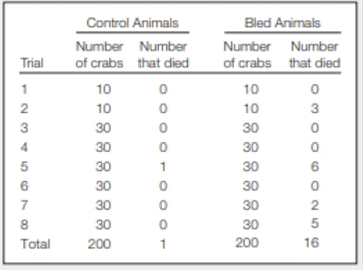
Concept explainers
Sustainable Use of Horseshoe Crabs Horseshoe crab blood clots immediately upon exposure to bacterial toxins, so it can be used to test injectable drugs for the presence of dangerous bacteria. To keep horseshoe crab populations stable, blood is extracted from captured animals, which are then returned to the wild. Concerns about the survival of animals after bleeding led researchers to do an experiment. They compared survival of animals captured and maintained in a tank with that of animals captured, bled, and kept in a similar tank. FIGURE 24.28 shows the results.

FIGURE 24.28 Mortality of young male horseshoe crabs kept in tanks during the 2 weeks after their capture. Half the animals were bled on the day of their capture. Control animals were handled, but not bled. This procedure was repeated 8 times with different sets of horseshoe crabs.
In which trial did the most control crabs die? In which did the most bled crabs die?
To explain: The trial in which the most control crabs died.
Introduction: Horseshoe crabs belong to the Phylum Arthropod. They are normally found around shallow ocean waters. Horseshoe crabs are living fossils. The horseshoe crabs though they look like crustaceans are marine arachnids.
Explanation of Solution
The uniqueness of horseshoe crabs is that they clot upon encountering bacteria. Therefore, they are used in experiments where highly virulent bacteria are involved. The blood of horseshoe crabs is taken and then let out in their habitat in order to conserve their population, but this might also lead to their death. Therefore, experiments were conducted to check their survival after taking their blood.
In trial 5, the number of control crabs is 30, and 1 crab died out of it.
The trial group 5 marked the highest number of control crabs that died.
Want to see more full solutions like this?
Chapter 24 Solutions
Biology: The Unity and Diversity of Life (MindTap Course List)
Additional Science Textbook Solutions
Physical Universe
Introductory Chemistry (6th Edition)
Genetics: From Genes to Genomes
Microbiology Fundamentals: A Clinical Approach
Human Physiology: An Integrated Approach (8th Edition)
- 4.arrow_forward2arrow_forward1. 2. 3. Marine fish cells are hypotonic compared to their seawater environment; their cells lose water by osmosis and gain solutes. If you add heterotrophic respiration and autotrophic respiration together and then subtract that value from gross primary productivity, then you have a more refined estimate of ecosystem carbon storage than NEE. Differential heating due to the earth's tilt generates the global wind AND oceanic circulation patternsarrow_forward
- KD 200- 116- 66- Vec ATF6 (670) ATF6 (402) ATF6 (373) ATF6 (366) I I 45- 1 2 3 4 5 ATFG (360) (e/c) 9V ATFG (402) g ant- ATF anti-KDEL DAPI barrow_forwardWestern blot results: what information can you get? Presence of proteins of your interest Levels of protein expression Levels of protein activation (must use activation state-specific antibody) Decreased function of the ATM kinase in aging mice. A C57BL/6 female 6 month Con IR 20 month C57BL/6 male 6 month 28 month Con IR Con IR Con IR p-ATM (S1981) ATM P-p53 (ser18) Actinarrow_forwardDoes it show the level of proteins? What about the amount? Levels of protein activation? How can you tell? Does the thickness tell you anything? What about the number of the lines?arrow_forward
 Biology: The Unity and Diversity of Life (MindTap...BiologyISBN:9781305073951Author:Cecie Starr, Ralph Taggart, Christine Evers, Lisa StarrPublisher:Cengage Learning
Biology: The Unity and Diversity of Life (MindTap...BiologyISBN:9781305073951Author:Cecie Starr, Ralph Taggart, Christine Evers, Lisa StarrPublisher:Cengage Learning Biology: The Dynamic Science (MindTap Course List)BiologyISBN:9781305389892Author:Peter J. Russell, Paul E. Hertz, Beverly McMillanPublisher:Cengage Learning
Biology: The Dynamic Science (MindTap Course List)BiologyISBN:9781305389892Author:Peter J. Russell, Paul E. Hertz, Beverly McMillanPublisher:Cengage Learning Biology Today and Tomorrow without Physiology (Mi...BiologyISBN:9781305117396Author:Cecie Starr, Christine Evers, Lisa StarrPublisher:Cengage Learning
Biology Today and Tomorrow without Physiology (Mi...BiologyISBN:9781305117396Author:Cecie Starr, Christine Evers, Lisa StarrPublisher:Cengage Learning Biology (MindTap Course List)BiologyISBN:9781337392938Author:Eldra Solomon, Charles Martin, Diana W. Martin, Linda R. BergPublisher:Cengage Learning
Biology (MindTap Course List)BiologyISBN:9781337392938Author:Eldra Solomon, Charles Martin, Diana W. Martin, Linda R. BergPublisher:Cengage Learning Biology 2eBiologyISBN:9781947172517Author:Matthew Douglas, Jung Choi, Mary Ann ClarkPublisher:OpenStax
Biology 2eBiologyISBN:9781947172517Author:Matthew Douglas, Jung Choi, Mary Ann ClarkPublisher:OpenStax





